Speed 15.5 knots (kts) Course 208° Location Canada Basin, 78.06° N, 136.33° W Depth 3684 meters
SPECIAL FEATURE DISCUSSION:
(see previous journal for the questions.)
Prior to canning, freezing, and refrigeration sailors on long voyages had to rely on other methods to keep food supplies secure. Once fresh produce and meat ran out, the main ways they had to keep a supply of food for months or even years were salting, curing, drying, and carrying livestock. Meat, for example, was heavily salted in brine and kept in barrels. Enough salt would prevent bacterial spoilage but rendered it inedible. To make it edible again it was soaked and boiled to get at least some of the salt out. Cured foods like hard cheeses and smoked sausages can be made to last for a while. Other staples like dried peas or fish could stay edible for long periods if kept from the damp. Dry, hard ship's biscuit (also known as hardtack) was notorious for its long-lasting qualities and cement-like constitution along with the annoying feature of growing tunneling insect larvae. Experienced sailors learned to tap their hardtack for a while on the table before biting into it to dislodge the bugs. For fresh meat, ships often left port with livestock like cows, pigs, sheep, or goats that they would eat later in the voyage. Ship's stores were supplemented when possible by making port calls to replenish fresh food and water, catching fish, or hunting for game along the way.
TODAY'S JOURNAL:
In anticipation of a recent CTDA research tool that is submerged in the water to measure conductivity (salinity), temperature, and depth. cast, the science team and Coast Guard crew members were invited to decorate styrofoam coffee cups. The cups were then loaded into mesh laundry bags and loaded on the CTDA research tool that is submerged in the water to measure conductivity (salinity), temperature, and depth. rosette. After lowering to about 3800 meters deep, the cups came back up shrunken to a small fraction of their original size! The gas bubbles in the styrofoam collapsed under the enormous pressure of the deep water, creating a Shrinky-Dink effect.
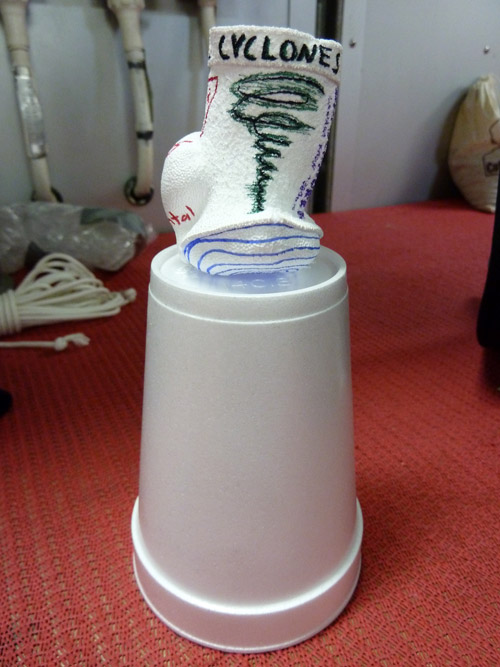
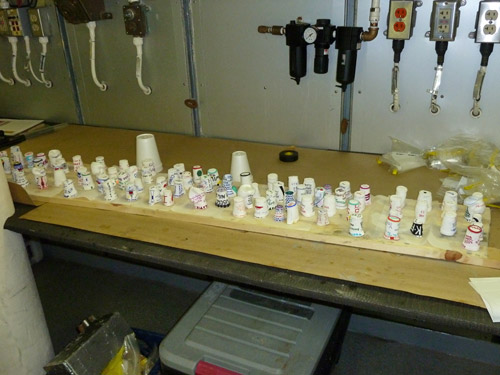
When the CTDA research tool that is submerged in the water to measure conductivity (salinity), temperature, and depth. rosette is brought back on board by the starboard side A-frame, it is wheeled into a work room through a big garage door. Then it is time for the water sampling team to jump into action. Some of the parameters they are measuring are time-sensitive so it is important for them to get their samples out of the Niskin bottles ASAP. There is an order of sampling that they do every time for consistency and to meet the requirements of each type of measurement. Samples are always begun on the #1 Niskin bottle, which has water from the deepest sampling level. Members of the team then proceed around the rosette until they get to the last bottle (#24 in the case of the bigger array.) Each Niskin bottle has a small vent cap at the top that is loosened and a nozzle at the bottom that opens when it is pulled out. For some of the sampling procedures a little hose is connected to the nozzle for retrieving water. For others, the sample container is filled directly from the nozzle. When there are five of us working on the rosette we can collect all of the needed samples from the 24 Niskin bottles in about an hour.
First, special bottles are filled and capped for later isotopes analysis.
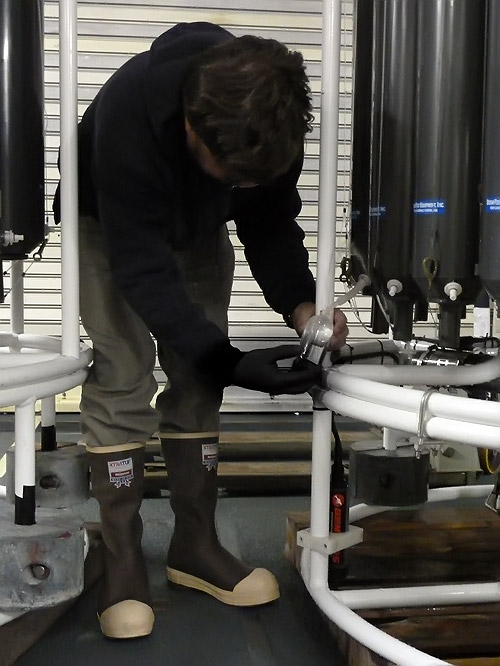
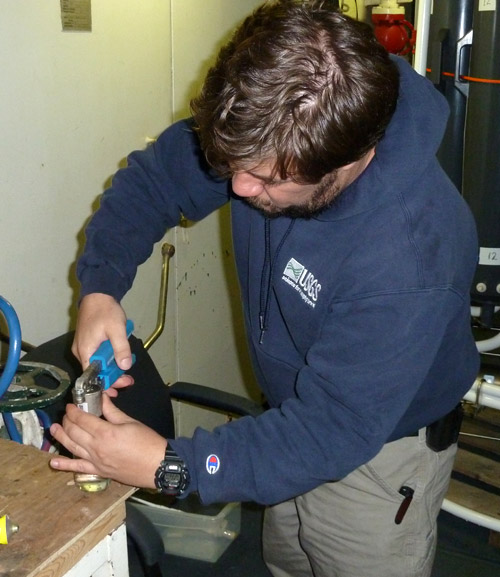
Next, 10 cm long, round clear tubes called spectrophotometric cells are flushed and filled for precision measurement of pH and carbonate content (CO3). The pH cells are made of glass but the carbonate cells are made of quartz (and much more expensive), since glass won't work with the ultraviolet light used to measure carbonate levels.
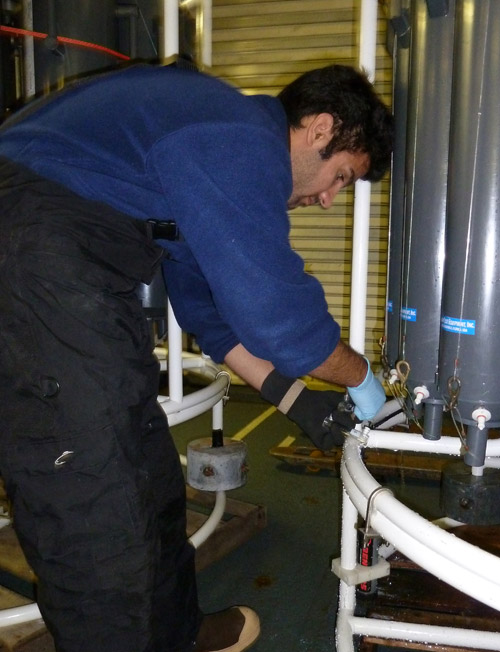
http://
Then samples are taken for dissolved inorganic carbon (DIC) and total alkalinity. The alkalinity samples fill special bottles with a very precise volume. They require a temperature measurement at the time the water is sampled from each Niskin bottle. As the water warms up and expands its volume will change, but by knowing the initial temperature and comparing that to its temperature when the total alkalinity is determined, an adjustment can be made for the change in volume to arrive at a more precise value.
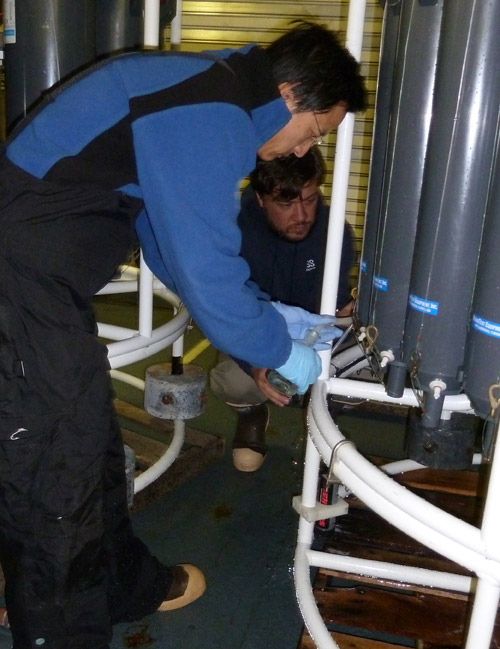
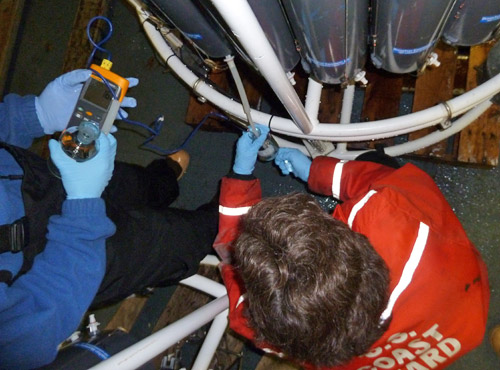
Finally, water is collected to analyze later for nutrients and total organic carbon. The nutrients samples are drawn off into a big syringe that forces the water through a very fine filter (.22 micron, or 22 hundred-millionths of a meter) as the small sample bottle is filled.
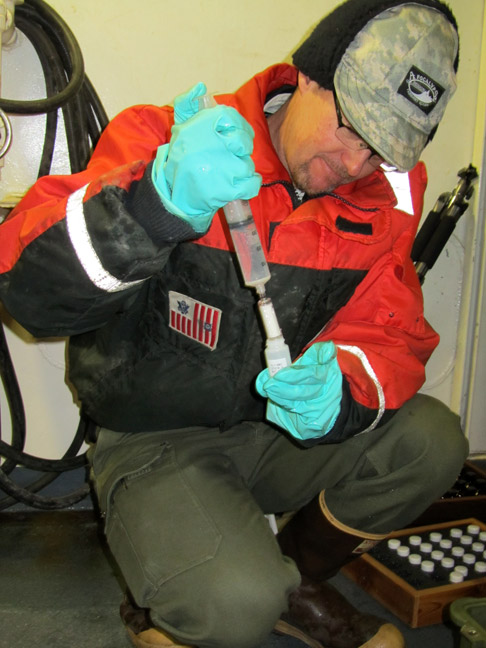
SPECIAL FEATURE:
Pressure in the oceans increases with depth. For every 10 meters deep the pressure increases by about 1 atmosphere (average sea-level air pressure.) About how much more pressure was on the cups when they were 3800 meters deep than when they were sitting in the science lab?
I'm looking forward to speaking with all you Centennial Cyclones live tomorrow during our PolarConnect event! That's all for now. Best- Bill


Comments